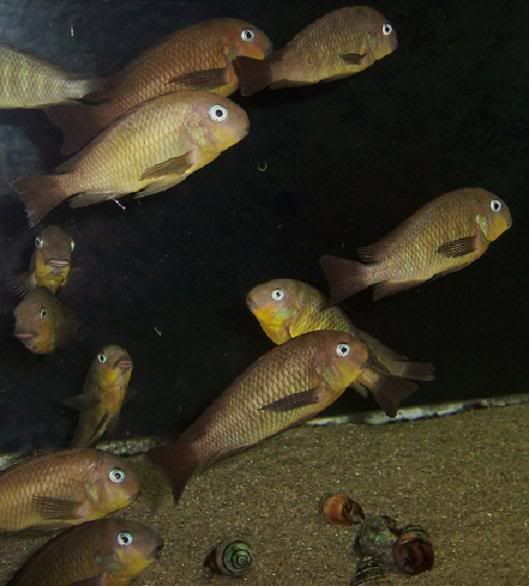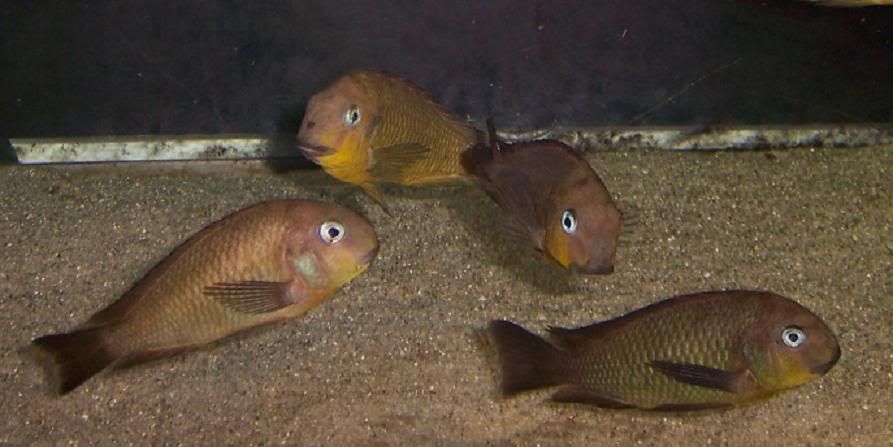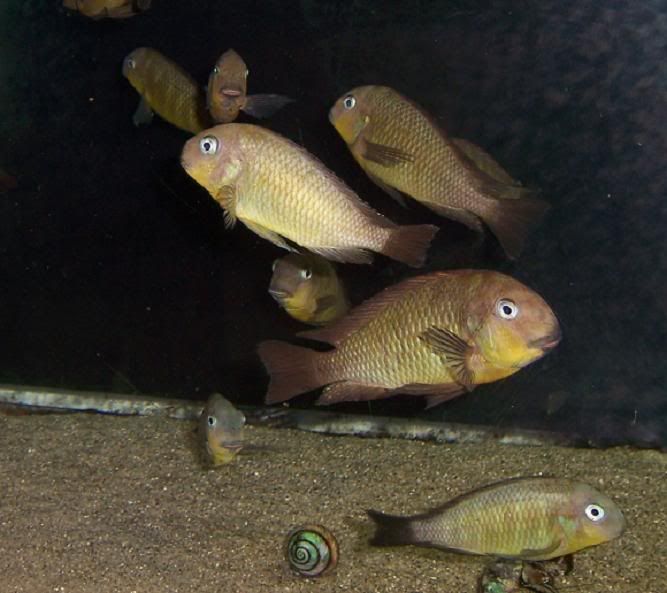Guys,
I just think these are the coolest looking brichardi variant. However, there is little information on the internet. I was hoping some of the experts can help with additional information. I found this link with good information but you need to do a yahoo translate to read it.
http://babelfish.yahoo.com/translate_url?trurl=http%3A%2F%2Ftanganyika-cichlids.com%2Fnamansi.htm&lp=fr_en&.intl=us&fr=yf p-t-501
There is also information in the aqualog on these fishes:
"Distribution: The distribution of this population lies in the vicinity of the village of Namansi in Tanasnia.
Discovered: This tropheus was probably discovered in 199 by Ad Konings and Laif DeMason during their exploration of the southern Tanzanian coast.
First importations: According to my information, this population was first offered for sale in Germany in 2000.
Coloration: In unstressed individuals the base colour consists of an orange-brown, which may be rather darker and greenish in the dorsal, and because vivid orange-yellow on the underside. The area below the eye is likewise bright orange-yellow. The iris is white-blue. There are bright pink-coloured ares around the eye, in the gill region, and at the base of the pectorals. Sometimes light vertical bars are faintly visible. Both sexes are the same colour, at least in neutral mood. Young fishes exhitbit a very striking juvenile which diminishes with the onset of sexual maturity and eventually disappears completely: they have a dark brown or, depending on viewpoint, bright red background, with vertical bars of the other colour. In 2001 a mutant form of this population was discovered, unfortunately I have only seen this fish in a photo on the internet. This individual was yellow-orange on the body while a small area on the back and part of the dorsal above it were dark in colour, likewise the caudal and a narrow marginal band in the dorsal.
Remarks: According to our current knowledge, this population is the southernmost representative of lineage 9. Itt escaped discovery for a long time die (sic) to the depth of its habitat. It lives on the same streach of coast as tropheus sp. "Namansi" (namansi red), population number 8.20, with the tropheus of the "rainbow lineage" preferring the supper part of the rocky littoral. This phenomenon is known from other parts of the lake Where is some cases up to four tropheus species share the biotope." by Peter Schupke.
Thanks in advance for any additional information.
I just think these are the coolest looking brichardi variant. However, there is little information on the internet. I was hoping some of the experts can help with additional information. I found this link with good information but you need to do a yahoo translate to read it.
http://babelfish.yahoo.com/translate_url?trurl=http%3A%2F%2Ftanganyika-cichlids.com%2Fnamansi.htm&lp=fr_en&.intl=us&fr=yf p-t-501
There is also information in the aqualog on these fishes:
"Distribution: The distribution of this population lies in the vicinity of the village of Namansi in Tanasnia.
Discovered: This tropheus was probably discovered in 199 by Ad Konings and Laif DeMason during their exploration of the southern Tanzanian coast.
First importations: According to my information, this population was first offered for sale in Germany in 2000.
Coloration: In unstressed individuals the base colour consists of an orange-brown, which may be rather darker and greenish in the dorsal, and because vivid orange-yellow on the underside. The area below the eye is likewise bright orange-yellow. The iris is white-blue. There are bright pink-coloured ares around the eye, in the gill region, and at the base of the pectorals. Sometimes light vertical bars are faintly visible. Both sexes are the same colour, at least in neutral mood. Young fishes exhitbit a very striking juvenile which diminishes with the onset of sexual maturity and eventually disappears completely: they have a dark brown or, depending on viewpoint, bright red background, with vertical bars of the other colour. In 2001 a mutant form of this population was discovered, unfortunately I have only seen this fish in a photo on the internet. This individual was yellow-orange on the body while a small area on the back and part of the dorsal above it were dark in colour, likewise the caudal and a narrow marginal band in the dorsal.
Remarks: According to our current knowledge, this population is the southernmost representative of lineage 9. Itt escaped discovery for a long time die (sic) to the depth of its habitat. It lives on the same streach of coast as tropheus sp. "Namansi" (namansi red), population number 8.20, with the tropheus of the "rainbow lineage" preferring the supper part of the rocky littoral. This phenomenon is known from other parts of the lake Where is some cases up to four tropheus species share the biotope." by Peter Schupke.
Thanks in advance for any additional information.












Comment